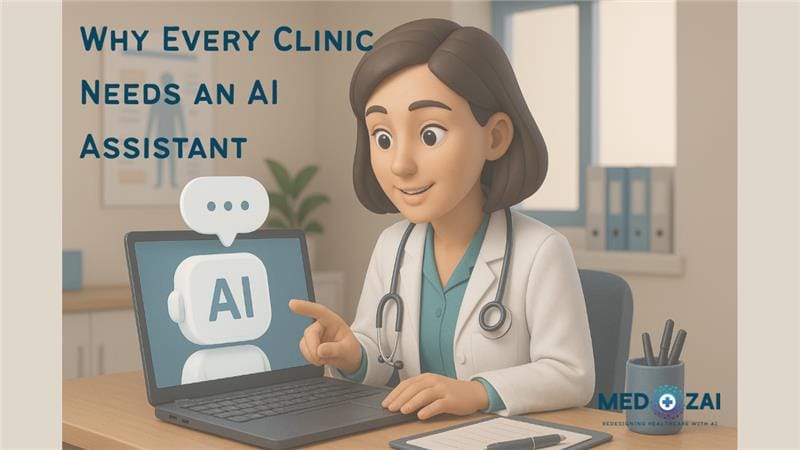Introduction
As small and mid-sized clinics in the US and Canada juggle patient care and administrative demands, AI assistants have emerged as a game-changer. These tools save time, reduce staff burden, and improve patient experience—all without requiring an overhaul of existing systems. For clinics interested in the broader role of Clinic AI, covering areas like smarter scheduling, documentation, and patient engagement, this approach is becoming central to outpatient care.
This post explores why clinics should pilot at least one AI assistant-highlighting real-world ROI, user-friendliness, and practical implementation.
Where AI Really Works in Your Clinic?
AI in healthcare isn’t just a future promise, it’s already solving real problems in clinics today. From cutting documentation time to reducing no-shows and improving diagnostic accuracy, AI assistants are actively transforming day-to-day operations. Below are seven practical areas where clinics are seeing measurable impact.
1. Streamlined Clinical Documentation
Ambient AI scribes transcribe in-visit conversations and generate clinical notes in real time. A survey from Stanford’s PHTI revealed clinicians felt sharper focus and documented more effectively after implementing these tools. Studies suggest documentation time can drop by up to 70%, freeing clinicians for patient care.
2. Front-Desk Automation & Chatbots
AI front-desk assistants can handle scheduling, reminders, intake verification, and follow-ups. Clinics report fewer no-shows and more efficient booking.
With Medozai’s intake agents, clinics in the US and Canada automate pre-visit documentation and appointment confirmations-fully integrated into front-desk workflows without disruptions.
The global healthcare chatbot market was valued at $376.09 million in 2023 and is projected to reach $1.88 billion by 2032, growing at a CAGR of 19.6%. This explosive growth reflects the increasing demand for scalable, AI-powered communication tools that can streamline patient engagement, appointment management, and intake workflows.
3. Revenue Cycle & Insurance Simplification
AI assistants now automate eligibility checks, claims submission, and denial management. Clinics using AI-augmented billing report notable improvements, such as cleaner claims, faster payments, and lower administrative burden. These efficiencies can indirectly boost collections.
4. Predictive Analytics & Inventory Management
AI tools help small clinics forecast patient demand, optimize staffing, and automate inventory planning. In a study published in the Journal of Healthcare Engineering, an ensemble of machine learning models, including Prophet and gradient boosting, improved patient flow forecasting accuracy by 16% to 30% over traditional in-house methods. Such predictive insights help clinics allocate resources more efficiently and respond proactively to patient demand.
5. Improved Diagnostic & Clinical Decision Support
Lightweight AI supports medication checks, referral suggestions, and care pathways. Research indicates AI tools can reduce overtreatment by up to 62% and improve diagnostic accuracy by over 30%.
6. Trust and Adoption in Everyday Practice
Success starts small. MGMA’s 2024 report found over 40% of clinics are adding or expanding AI tools this year, especially ambient AI and triage/chat functions.
With Medozai’s adoption model, outpatient clinics across the US and Canada begin with one assistant-such as an intake or documentation agent-measure improvements, then expand based on proven value.
7. Calculating Real ROI
Calculate ROI across three dimensions:
- Operational: reduced staff hours, improved workflow.
- Financial: faster claims, fewer no-shows, more collections.
- Experiential: better clinician well-being, enhanced patient experience
More than 70% of healthcare organizations using generative AI report meeting or exceeding ROI expectations. Costs range from under $40K for modular pilots to $100K+ for full-scale deployments. For many North American clinics, ROI often materializes within 12–30 months
What’s the average ROI clinics see after switching to AI-driven scheduling assistants?
ROI varies based on practice size and integration depth, but clinics implementing AI-driven scheduling assistants have reported measurable operational and financial benefits.
For example, Weill Cornell Medicine saw a 47% increase in digital bookings using an AI chatbot. Clinics also reduce no-shows, deflect routine calls, and free staff for higher-value tasks — all contributing to long-term ROI.
According to MGMA (2025), properly integrated AI assistants help clinics realize value through improved access, efficiency, and revenue impact.
Suggested Reading: Average ROI Clinics for AI-Driven Scheduling Assistants (In-depth Research)
8. Practical Path to Adoption
After seeing where AI delivers the most impact, the next step is knowing how to implement it effectively. Many clinics succeed by starting small, piloting a single workflow, measuring outcomes, and scaling based on real results. This section outlines a practical, low-risk path to bring AI assistants into your clinic without disruption.
- Start with a Narrow Use Case:
Pilot a single pain point-like documentation or intake-to collect baseline metrics.
- Use Interoperable Tools:
Choose assistants designed for seamless integration with your EHR system.
- Monitor Key Metrics:
Track time savings, billing efficiency, and patient satisfaction over 3–6 months.
- Scale Responsibly:
Once ROI is validated, add agents for billing, analytics, triage, etc., to expand value.
Conclusion
In small and mid-sized clinics, AI assistants are not futuristic—they’re essential. They reduce administrative burden, optimize revenue, and enhance patient-clinician interactions, all with measurable ROI. Pilot one use case, gather data, then scale—that’s the practical path to smarter, leaner healthcare operations. To see how these assistants fit into the wider movement toward smarter, patient-centric care with Clinic AI, explore how clinics are already adopting AI across documentation, scheduling, and patient engagement.
Frequently Asked Questions (FAQs)
1. What is the typical cost of an AI assistant pilot?
Modular pilots start below $40K, scaling based on workflow complexity.
2. How soon can ROI be realized?
Clinics often see ROI in 12–30 months, depending on usage and efficiency gains.
3. Are these tools compatible with EHRs?
Yes-most AI assistants are designed to integrate with Epic, Cerner, Meditech, Athena and other EHR systems.
4. Does AI replace Clinic staff?
No-AI automates repetitive tasks, enabling staff to focus on patient care rather than reducing headcount
5. Is my data secure with AI tools?
With proper vendor due diligence and HIPAA compliance, AI assistants can safely operate within clinical environments.


Trackbacks/Pingbacks